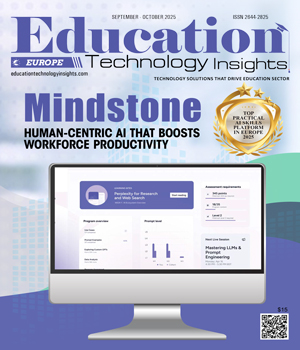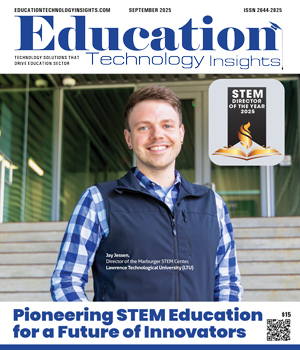THANK YOU FOR SUBSCRIBING
Be first to read the latest tech news, Industry Leader's Insights, and CIO interviews of medium and large enterprises exclusively from Education Technology Insights
Transforming IT Education with Hands-On Practical Learning
Dr. John R. Wetsch, Program Director for Cloud Computing/Instructor, Wake Technical Community College
 Dr. John R. Wetsch, Program Director for Cloud Computing/Instructor, Wake Technical Community College
Dr. John R. Wetsch, Program Director for Cloud Computing/Instructor, Wake Technical Community CollegeWith over 30 years in government, industry, and higher education, John specializes in teaching information technology by connecting theory to real-world application. He focuses on building student confidence through hands-on experience with technologies and tools, preparing learners to adapt in a rapidly evolving tech landscape.
I use a mix of media—text, video, and discussion—to support diverse learning styles, delivering content both online and in person to ensure accessibility and engagement. My philosophy centers on helping students understand how hardware, software, storage and communications integrate into functioning systems. I frame this through the systems development life cycle, always aligned with business needs. This prepares students to adapt and thrive with emerging technologies like cloud computing, AI and machine learning. Ultimately, I want students to leave my courses ready to apply their knowledge in meaningful, practical ways.
Over 30 years of teaching STEM subjects— both in the classroom and online—I’ve seen educational technology evolve dramatically. What remains essential is using platforms that promote active engagement, authentic problem-solving and, when applicable, real-time feedback. Interactive development environments (IDEs) like Visual Studio are foundational for teaching programming, enabling students to write, debug and test code in real time. CASE tools and modeling platforms help students visualize systems and collaborate on design, making abstract concepts more tangible.
Remote lab systems and virtual machines— through platforms like AWS Educate and Azure Lab Services—allow students to interact with real-world environments, especially in cybersecurity and cloud computing. Collaboration tools foster shared learning, while robust learning management systems (LMS) support instruction through analytics on student performance and engagement. Ultimately, the most effective technologies are those that integrate seamlessly into the learning experience, allowing students to focus on solving problems and building systems. My goal is to cultivate technological fluency—the ability to adapt, learn and innovate across platforms. That’s what prepares students not just for exams, but for the evolving demands of the real world.
Turning a Struggling C++ Class into a Success
One of the most challenging teaching experiences I faced was stepping into a C++ programming course midstream. I received a call to teach the class, which met twice a week for three and a half hours, over ten weeks. I accepted, only to learn that the previous instructor had been let go after two weeks, students were disengaged and I was handed the textbook with little context. When I arrived, the classroom was silent—arms crossed, faces skeptical. I introduced myself and asked where they had left off. No response. Eventually, one student shared that they hadn’t done a single C++ lesson. The previous instructor had discussed unrelated computer topics and hadn’t even used the lab computers.
“Students thrive when given opportunities to wrestle with ambiguity and explore multiple solutions. These habits of mind also prepare them for success in a rapidly evolving technological landscape”
We started by simply turning on the machines and diving into the first lesson. After a short break, I had the students introduce themselves. That moment changed everything. I learned they were all professional programmers taking the course to learn C++ for work. They had prior experience, but felt their time had been wasted. To catch up, I fast-tracked basic logic instruction and focused on the core material. We completed the course successfully, and student feedback was overwhelmingly positive. This experience taught me the importance of assessing where students are—academically and professionally—and adapting instruction accordingly. It’s a lesson I carry into every course: meet students where they are and build from there.
Identifying and Nurturing High-Potential Students
I observe engagement patterns, noting how students respond to complexity, challenge assumptions and connect ideas across domains. High-potential learners often demonstrate an early capacity for critical analysis, asking not just “how” but “why.” To sustain their momentum, I offer enrichment tasks that require synthesis, evaluation and creative problem-solving skills. I believe these skills are at the heart of critical thinking. Students can thrive when given opportunities to wrestle with ambiguity and explore multiple solutions. These habits of mind also prepare them for success in a rapidly evolving 21st century technological landscape.
Most Importantly, I believe this potential exists in all students. Everyone should have the opportunity to shine and develop their mettle in the classroom. By fostering a supportive and intellectually curious environment, I aim to help each learner discover their strengths and grow into confident, adaptive thinkers. When listening to tech employers, their expectations are clear: they trust our graduates will possess the foundational skills, but they also seek curiosity, adaptability and a willingness to engage with emerging technologies. I believe my learner-centered strategies align well with these industry needs, equipping students not only to meet current demands but to thrive amid future change.
Read Also
From At-Risk to At-Promise: The Language Revolution Higher Education Needs
Teaching Tomorrow: How Western Governors University Is Redefining Teacher Preparation
Shaping Future Engineers Through Innovation and Hands-On Learning
From Isolation to Interaction: Reimagining Technology for Human Connection
Building an Understanding of AI in Learning Environments
Integrating SEL, Digital Citizenship, and AI Literacy in K–8 Schools

I agree We use cookies on this website to enhance your user experience. By clicking any link on this page you are giving your consent for us to set cookies. More info

However, if you would like to share the information in this article, you may use the link below:
www.educationtechnologyinsightseurope.com/cxoinsights/dr-john-r-wetsch-nid-3414.html





















